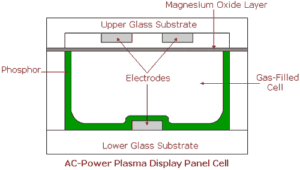In the search for a large sized flat screen display technology, LCDs do not have the field all to themselves. Though late to join the commercial battle, the next flat large screen devices being commercialised are plasma display panels (PDPs), a technology developed from the principle of the fluorescent (or “strip”) light.
In a fluorescent light, an electric field is passed through a gas held at a low pressure inside a glass tube, causing the gas to become ionised and change state, becoming a plasma (an electrically conducting medium containing roughly equal numbers of positively and negatively charged particles) and giving off ultraviolet radiation. This radiation strikes the outside of the glass tube, which is coated with phosphor, causing the phosphor to give off visible light.
There are several ways to produce a plasma display panel. Currently, the most commonly used is the alternating current (AC) powered “side discharge” type (illustrated). Like fluorescent light tubes, this type of PDP initially requires a high voltage to cause the gas (commonly a mixture of xenon and neon) to change state but, thereafter, needs only a small voltage to maintain the reaction. For this reason, two transparent electrodes are built into the top glass substrate: one to initiate the reaction; one to maintain it.
The other system is the direct current (DC) powered type which, like the LCD, uses just two electrodes, one above and one below each cell. However, the DC-powered PDP requires a higher operating voltage than the AC-powered design, has a shorter life span, a narrower viewing angle and lower contrast. No commercial products are currently in development using DC techniques although some research is still going on.
Fujitsu, an early developer of PDPs which favours the AC-powered design, has developed a new type of panel using a technique which it calls “Alternate Lighting of Surfaces” (ALiS), in which the top electrodes are positioned at the edges of each cell and are able, in effect, to address each half of the cell independently, doubling the number of lines in the display. ALiS is also said to produce a PDP twice as bright as the standard AC-powered display and, being an interlaced scanning system, to be particularly suited to HD TV use.
Update: PDP has developed very rapidly, especially with the arrival of the large Korean players, LG Electronics and Samsung SDI and with the remaining Japanese companies, Matsushita (Panasonic), NEC and Pioneer combining their development efforts. PDP is the dominant direct view TV technology in sizes of 42″ and above at the moment although it is under threat from LCD at sizes below 50″. PDP has struggled to achieve high efficiency with small pixel size, so is appropriate only for large and relatively low resolution applications such as TV.

